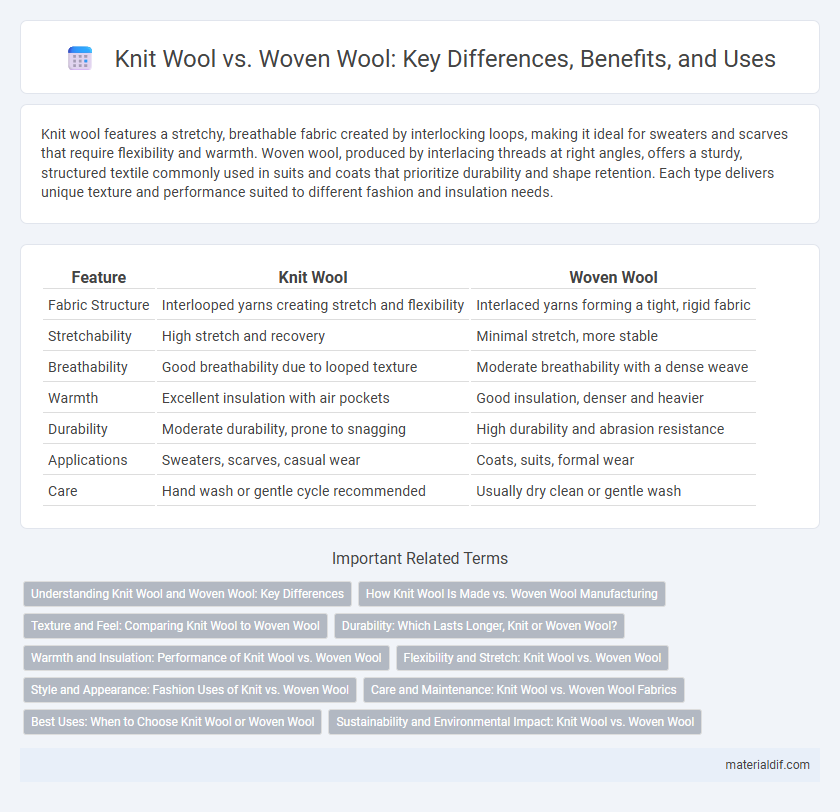Knit wool features a stretchy, breathable fabric created by interlocking loops, making it ideal for sweaters and scarves that require flexibility and warmth. Woven wool, produced by interlacing threads at right angles, offers a sturdy, structured textile commonly used in suits and coats that prioritize durability and shape retention. Each type delivers unique texture and performance suited to different fashion and insulation needs.
Table of Comparison
| Feature | Knit Wool | Woven Wool |
|---|---|---|
| Fabric Structure | Interlooped yarns creating stretch and flexibility | Interlaced yarns forming a tight, rigid fabric |
| Stretchability | High stretch and recovery | Minimal stretch, more stable |
| Breathability | Good breathability due to looped texture | Moderate breathability with a dense weave |
| Warmth | Excellent insulation with air pockets | Good insulation, denser and heavier |
| Durability | Moderate durability, prone to snagging | High durability and abrasion resistance |
| Applications | Sweaters, scarves, casual wear | Coats, suits, formal wear |
| Care | Hand wash or gentle cycle recommended | Usually dry clean or gentle wash |
Understanding Knit Wool and Woven Wool: Key Differences
Knit wool is created by interlocking loops of yarn, resulting in a stretchy, flexible fabric ideal for sweaters and scarves, while woven wool is produced by interlacing yarns perpendicularly, offering greater durability and structure suited for suits and coats. The elasticity of knit wool provides superior insulation and comfort, whereas woven wool's dense construction enhances wind resistance and shape retention. Understanding these key differences helps in selecting the appropriate wool fabric for specific clothing needs based on texture, breathability, and purpose.
How Knit Wool Is Made vs. Woven Wool Manufacturing
Knit wool is created by interlocking loops of wool yarn using knitting needles or machines, producing a stretchy and flexible fabric ideal for garments like sweaters and scarves. In contrast, woven wool is made by interlacing two sets of yarns at right angles on a loom, resulting in a firmer and more durable fabric commonly used for suits and coats. The manufacturing process for knit wool allows for greater elasticity, while woven wool provides structural stability and resistance to wear.
Texture and Feel: Comparing Knit Wool to Woven Wool
Knit wool features a flexible, stretchable texture created by interlocking loops, resulting in a soft, cozy feel ideal for garments like sweaters and scarves. Woven wool, crafted by interlacing yarns at right angles, has a firmer, more structured texture that offers durability and a polished appearance typical in suits and outerwear. The differing construction techniques significantly influence the tactile experience and drape, with knit wool emphasizing comfort and woven wool prioritizing resilience and form.
Durability: Which Lasts Longer, Knit or Woven Wool?
Knit wool offers flexibility and stretch but may wear out faster due to its looped structure, making it less durable over time compared to woven wool. Woven wool features a tighter, interlaced fiber pattern that provides greater strength and resistance to abrasion, enhancing longevity. For long-lasting garments, woven wool typically outperforms knit wool in durability, especially under frequent use and stress.
Warmth and Insulation: Performance of Knit Wool vs. Woven Wool
Knit wool offers superior warmth and insulation due to its looser, looped construction, which traps heat and allows better airflow, enhancing thermal regulation. Woven wool, with its tighter, interlaced fibers, provides durability and less air permeability but tends to be less insulating compared to knit wool. Performance-wise, knit wool excels in retaining body heat, making it ideal for cold-weather clothing, while woven wool suits outerwear requiring structural stability and moderate warmth.
Flexibility and Stretch: Knit Wool vs. Woven Wool
Knit wool offers superior flexibility and stretch due to its looped construction, allowing garments to move with the body and provide enhanced comfort. Woven wool, characterized by interlaced yarns, has a more rigid structure that limits its stretch but provides greater durability and shape retention. These differences make knit wool ideal for activewear and fitted clothing, while woven wool suits tailored pieces requiring structure.
Style and Appearance: Fashion Uses of Knit vs. Woven Wool
Knit wool offers a soft, flexible texture ideal for casual and cozy fashion pieces such as sweaters and scarves, emphasizing comfort and stretch. Woven wool provides a structured, crisp appearance suited for tailored garments like suits, coats, and skirts, delivering a polished and professional look. The choice between knit and woven wool significantly impacts the garment's drape, durability, and overall style statement in fashion design.
Care and Maintenance: Knit Wool vs. Woven Wool Fabrics
Knit wool fabrics require gentle hand washing or delicate machine cycles with cool water to prevent stretching and maintain elasticity, while woven wool benefits from dry cleaning to preserve its structured weave and prevent shrinkage. Proper drying techniques differ: knit wool should be laid flat to dry to avoid distortion, whereas woven wool maintains shape better when dried on a flat surface or hung carefully. Regular brushing and airing out both types help remove dirt and odors, extending the lifespan of knit and woven wool garments.
Best Uses: When to Choose Knit Wool or Woven Wool
Knit wool excels in stretchability and warmth, making it ideal for activewear, sweaters, and cozy garments requiring flexibility. Woven wool offers durability and a structured form best suited for tailored suits, coats, and formal wear where shape retention is critical. Choose knit wool for comfort and mobility, while woven wool is preferred for classic, polished looks and heavy-duty outerwear.
Sustainability and Environmental Impact: Knit Wool vs. Woven Wool
Knit wool typically uses less energy and water during production compared to woven wool, making it a more sustainable choice for eco-conscious consumers. The manufacturing process of knit wool reduces material waste due to its seamless construction, whereas woven wool often requires cutting and sewing, leading to higher fabric waste. Both knit and woven wool are biodegradable, but the lower environmental footprint of knit wool production supports reduced carbon emissions and resource consumption.
Knit Wool vs Woven Wool Infographic

 materialdif.com
materialdif.com